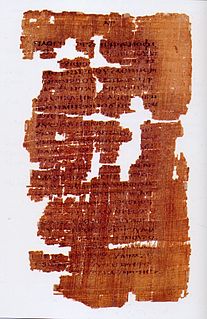 W
WThe Gospel of Basilides is the title given to a reputed text within the New Testament apocrypha, which is reported in the middle of the third century as then circulating amongst the followers of Basilides (Βασιλείδης), a leading theologian of Gnostic tendencies, who had taught in Alexandria in the second quarter of the second century. Basilides's teachings were condemned as heretical by Irenaeus of Lyons, and by Hippolytus of Rome, although they had been evaluated more positively by Clement of Alexandria. There is, however, no agreement amongst Irenaeus, Hippolytus or Clement as to Basilides's specific theological opinions; while none of the three report a gospel in the name of Basilides.
 W
WThe Egerton Gospel refers to a collection of three papyrus fragments of a codex of a previously unknown gospel, found in Egypt and sold to the British Museum in 1934; the physical fragments are now dated to the very end of the 2nd century CE. Together they comprise one of the oldest surviving witnesses to any gospel, or any codex. The British Museum lost no time in publishing the text: acquired in the summer of 1934, it was in print in 1935. It is also called the Unknown Gospel, as no ancient source makes reference to it, in addition to being entirely unknown before its publication.
 W
WThe Gospel of the Hebrews, or Gospel according to the Hebrews, was a syncretic Jewish–Christian gospel. The text of the gospel is lost with only fragments of it surviving as brief quotations by the early Church Fathers and in apocryphal writings. The fragments contain traditions of Jesus' pre-existence, incarnation, baptism, and probable temptation, along with some of his sayings. Distinctive features include a Christology characterized by the belief that the Holy Spirit is Jesus' Divine Mother and a first resurrection appearance to James, the brother of Jesus, showing a high regard for James as the leader of the Jewish Christian church in Jerusalem. It was probably composed in Greek in the first decades of the 2nd century, and is believed to have been used by Greek-speaking Jewish Christians in Egypt during that century.
 W
WThe Gospel of the Saviour is a fragmentary Coptic text from an otherwise unknown gospel that has joined the New Testament apocrypha. It consists of a fragmentary fire-damaged parchment codex that was acquired by the Egyptian Museum of Berlin in 1961. Its nature was only discovered in 1991, when it came round to being conserved, and was revealed in a 1996 lecture by Charles W. Hedrick. It has been edited and translated into English by Hedrick and Paul Mirecki and by Bart D. Ehrman. The fragmentary nature of the text admits of more than one sequential ordering of the contents, giving rise to more than one useful translation, and some public discussion.
 W
WThe Living Gospel was a 3rd-century gnostic gospel written by Mani. It was originally written in Syriac and called the Evangelion, from the Greek: εὐαγγέλιον and was one of the seven original scriptures of Manichaeism. A number of fragments are preserved in the Cologne Mani-Codex and on manuscript fragments found in Turfan beginning in 1904. Some Coptic manuscript fragments recovered at Fayyum appear to contain a sort of commentary or homily on the gospel.
 W
WThe Gospel of Matthias is a lost text from the New Testament apocrypha, ascribed to Matthias, the apostle chosen by lots to replace Judas Iscariot. The content has been surmised from various descriptions of it in ancient works by church fathers. There is too little evidence to decide whether a Traditions of Matthias is the same work, according to J.B. Matthews, The Anchor Bible Dictionary (IV:644).
 W
WThe Secret Gospel of Mark or the Mystic Gospel of Mark, also the Longer Gospel of Mark, is a putative longer and secret or mystic version of the Gospel of Mark. The gospel is mentioned exclusively in the Mar Saba letter, a document of disputed authenticity, which is said to be written by Clement of Alexandria. This letter, in turn, is preserved only in photographs of a Greek handwritten copy seemingly transcribed in the eighteenth century into the endpapers of a seventeenth-century printed edition of the works of Ignatius of Antioch.
 W
WThe Gospel of the Twelve, possibly also referred to as the Gospel of the Apostles, is a lost gospel mentioned by Origen in Homilies on Luke as part of a list of heretical works.